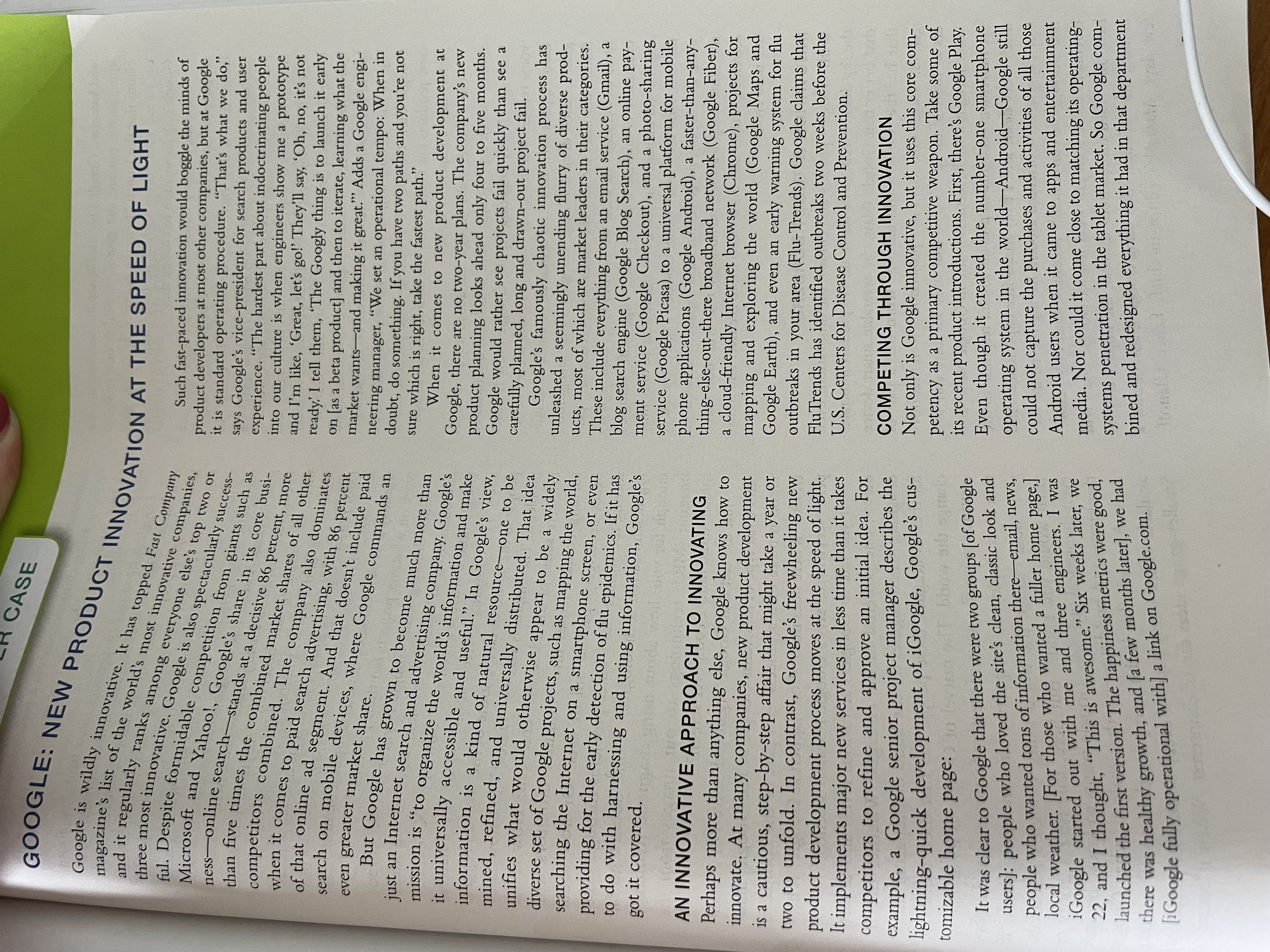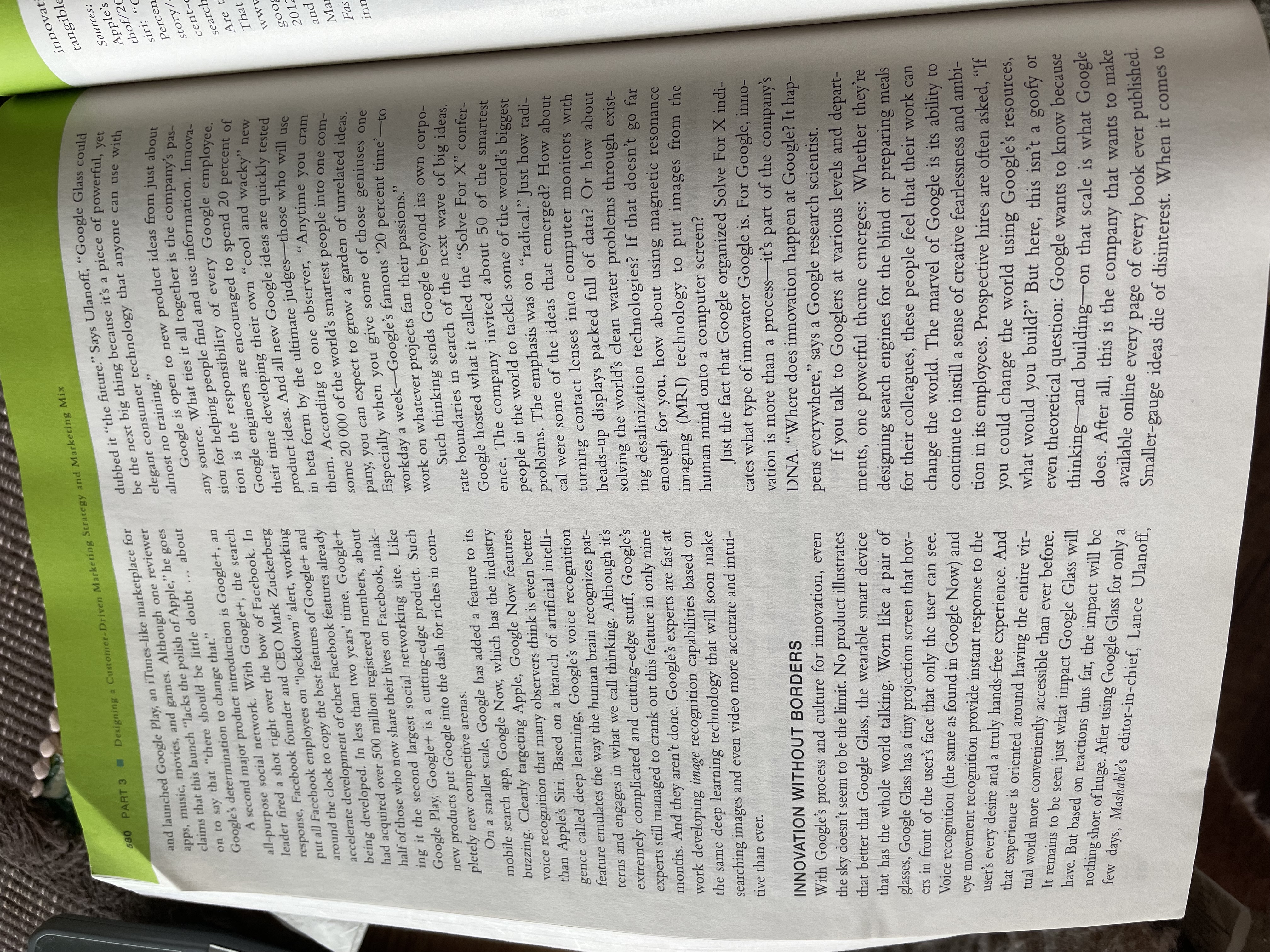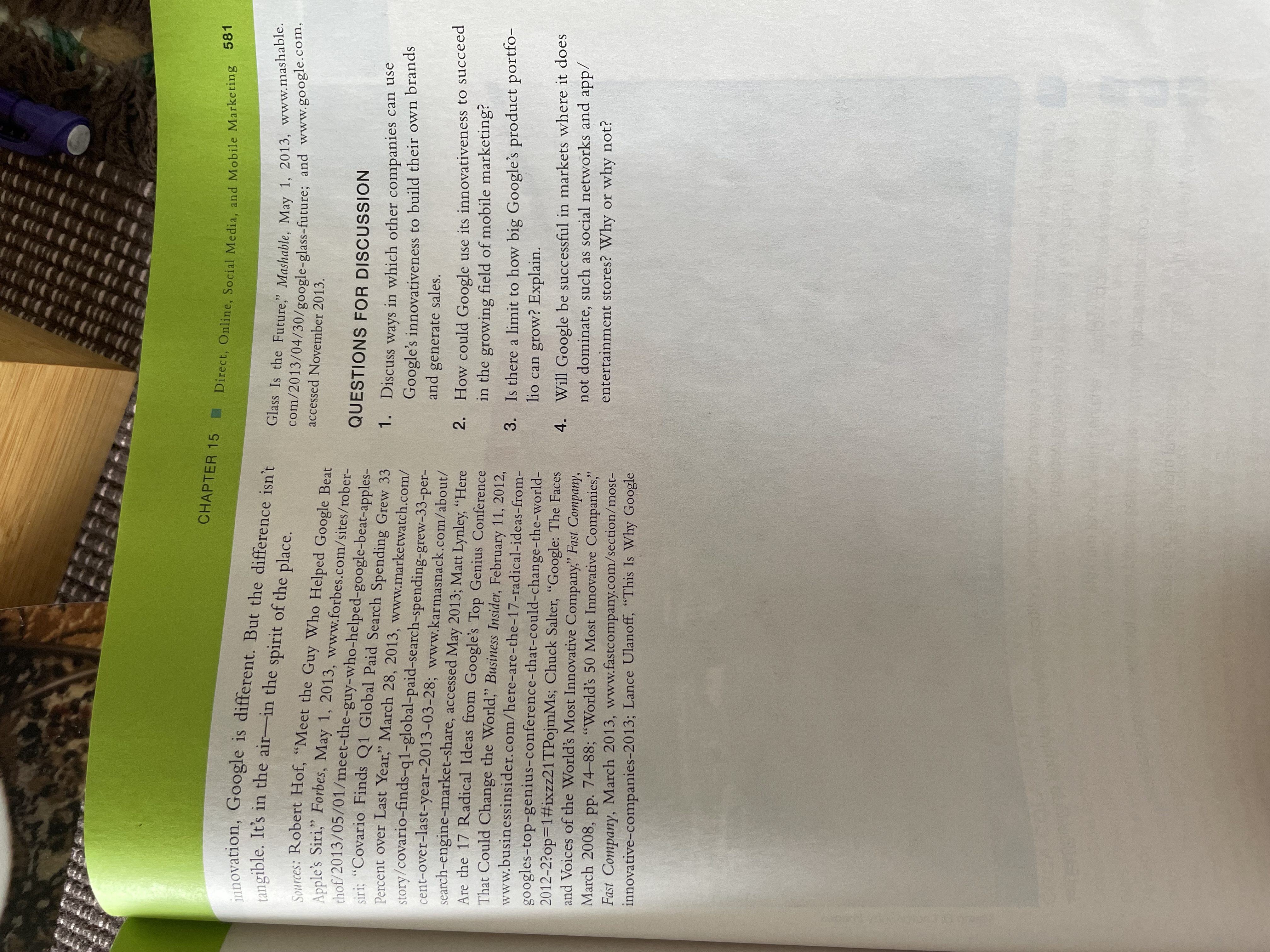Answered step by step
Verified Expert Solution
Question
1 Approved Answer
CASE GOOGLE: NEW PRODUCT INNOVATION AT THE SPEED OF LIGHT Google is wildly innovative. It has topped Fast Company magazine's list of the world's



CASE GOOGLE: NEW PRODUCT INNOVATION AT THE SPEED OF LIGHT Google is wildly innovative. It has topped Fast Company magazine's list of the world's most innovative companies, and it regularly ranks among everyone else's top two or three most innovative. Google is also spectacularly success- ful. Despite formidable competition from giants such as Microsoft and Yahoo!, Google's share in its core busi- ness online search-stands at a decisive 86 percent, more than five times the combined market shares of all other competitors combined. The company also dominates when it comes to paid search advertising, with 86 p even greater market share. of that online ad segment. And that doesn't include paid search on mobile devices, where Google commands an percent But Google has grown to become much more than just an Internet search and advertising company. Google's mission is "to organize the world's information and make it universally accessible and useful." In Google's view, information is a kind of natural resource-one to be mined, refined, and universally distributed. That idea unifies what would otherwise appear to be a widely diverse set of Google projects, such as mapping the world, searching the Internet on a smartphone screen, or even providing for the early detection of flu epidemics. If it has got it covered. to do with harnessing and using information, Google's AN INNOVATIVE APPROACH TO INNOVATING Perhaps more than anything else, Google knows how to innovate. At many companies, new product development is a cautious, step-by-step affair that might take a year or two to unfold. In contrast, Google's freewheeling new product development process moves at the speed of light. It implements major new services in less time than it takes competitors to refine and approve an initial idea. For example, a Google senior project manager describes the lightning-quick development of iGoogle, Google's cus- tomizable home page:) to It was clear to Google that there were two groups [of Google users]: people who loved the site's clean, classic look and people who wanted tons of information there-email, news, local weather. [For those who wanted a fuller home page,] iGoogle started out with me and three engineers. I was 22, and I thought, "This is awesome." Six weeks later, we launched the first version. The happiness metrics were good, there was healthy growth, and [a few months later], we had Google fully operational with] a link on Google.com. esothris Such fast-paced innovation would boggle the minds of product developers at most other companies, but at Google it is standard operating procedure. "That's what we do," says Google's vice-president for search products and user experience. "The hardest part about indoctrinating people into our culture is when engineers show me a prototype and I'm like, 'Great, let's go!' They'll say, 'Oh, no, it's not ready. I tell them, 'The Googly thing is to launch it early on [as a beta product] and then to iterate, learning what the market wants and making it great." Adds a Google engi- neering manager, "We set an operational tempo: When in doubt, do something. If you have two paths and you're not sure which is right, take the fastest path." When it comes to new product development at Google, there are no two-year plans. The company's new product planning looks ahead only four to five months. Google would rather see projects fail quickly than see a carefully planned, long and drawn-out project fail. Google's famously chaotic innovation process has unleashed a seemingly unending flurry of diverse prod- ucts, most of which are market leaders in their categories. These include everything from an email service (Gmail), a blog search engine (Google Blog Search), an online pay- ment service (Google Checkout), and a photo-sharing service (Google Picasa) to a universal platform for mobile phone applications (Google Android), a faster-than-any- thing-else-out-there broadband network (Google Fiber), a cloud-friendly Internet browser (Chrome), projects for mapping and exploring the world (Google Maps and Google Earth), and even an early warning system for flu outbreaks in your area (Flu-Trends). Google claims that Flu Trends has identified outbreaks two weeks before the U.S. Centers for Disease Control and Prevention. COMPETING THROUGH INNOVATION Not only is Google innovative, but it uses this core com- petency as a primary competitive weapon. Take some of its recent product introductions. First, there's Google Play. Even though it created the number-one smartphone operating system in the world-Android-Google still could not capture the purchases and activities of all those Android users when it came to apps and entertainment media. Nor could it come close to matching its operating- systems penetration in the tablet market. So Google com- bined and redesigned everything it had in that department traf 115 680 PART 3 # Designing a Customer-Driven Marketing Strategy and Marketing Mix and launched Google Play, an iTunes-like marketplace for apps, music, movies, and games. Although one reviewer claims that this launch "lacks the polish of Apple," he goes on to say that "there should be little doubt ... about Google's determination to change that." A second major product introduction is Google+, an all-purpose social network. With Google+, the search leader fired a shot right over the bow of Facebook. In response, Facebook founder and CEO Mark Zuckerberg put all Facebook employees on "lockdown" alert, working around the clock to copy the best features of Google+ and accelerate development of other Facebook features already being developed. In less than two years' time, Google+ had acquired over 500 million registered members, about half of those who now share their lives on Facebook, mak- ing it the second largest social networking site. Like Google Play, Google+ is a cutting-edge product. Such new products put Google into the dash for riches in com- pletely new competitive arenas. On a smaller scale, Google has added a feature to its mobile search app, Google Now, which has the industry buzzing. Clearly targeting Apple, Google Now features voice recognition that many observers think is even better than Apple's Siri. Based on a branch of artificial intelli- gence called deep learning, Google's voice recognition feature emulates the way the human brain recognizes pat- terns and engages in what we call thinking. Although it's extremely complicated and cutting-edge stuff, Google's experts still managed to crank out this feature in only nine months. And they aren't done. Google's experts are fast at work developing image recognition capabilities based on the same deep learning technology that will soon make searching images and even video more accurate and intui- tive than ever. dubbed it "the future." Says Ulanoff, "Google Glass could be the next big thing because it's a piece of powerful, yet elegant consumer technology that anyone can use with almost no training. Google is open to new product ideas from just about any source. What ties it all together is the company's pas- sion for helping people find and use information. Innova- tion is the responsibility of every Google employee. Google engineers are encouraged to spend 20 percent of their time developing their own "cool and wacky" new product ideas. And all new Google ideas are quickly tested in beta form by the ultimate judges-those who will use them. According to one observer, "Anytime you cram some 20 000 of the world's smartest people into one com- pany, you can expect to grow a garden of unrelated ideas. Especially when you give some of those geniuses one workday a week-Google's famous '20 percent time'-to work on whatever projects fan their passions." Such thinking sends Google beyond its own corpo- rate boundaries in search of the next wave of big ideas. Google hosted what it called the "Solve For X" confer- ence. The company invited about 50 of the smartest people in the world to tackle some of the world's biggest problems. The emphasis was on "radical." Just how radi- cal were some of the ideas that emerged? How about turning contact lenses into computer monitors with heads-up displays packed full of data? Or how about solving the world's clean water problems through exist- ing desalinization technologies? If that doesn't go far enough for you, how about using magnetic resonance imaging (MRI) technology to put images from the human mind onto a computer screen? Just the fact that Google organized Solve For X indi- cates what type of innovator Google is. For Google, inno- vation is more than a process-it's part of the company's DNA. "Where does innovation happen at Google? It hap- pens everywhere," says a Google research scientist. If you talk to Googlers at various levels and depart- ments, one powerful theme emerges: Whether they're designing search engines for the blind or preparing meals for their colleagues, these people feel that their work can change the world. The marvel of Google is its ability to continue to instill a sense of creative fearlessness and ambi- tion in its employees. Prospective hires are often asked, "If you could change the world using Google's resources, what would you build?" But here, this isn't a goofy or even theoretical question: Google wants to know because thinkingand building on that scale is what Google does. After all, this is the company that wants to make available online every page of every book ever published. Smaller-gauge ideas die of disinterest. When it comes to INNOVATION WITHOUT BORDERS With Google's process and culture for innovation, even the sky doesn't seem to be the limit. No product illustrates that better that Google Glass, the wearable smart device that has the whole world talking. Worn like a pair of glasses, Google Glass has a tiny projection screen that hov- ers in front of the user's face that only the user can see. Voice recognition (the same as found in Google Now) and eye movement recognition provide instant response to the every desire and a truly hands-free experience. And that experience is oriented around having the entire vir- tual world more conveniently accessible than ever before. It remains to be seen just what impact Google Glass will have. But based on reactions thus far, the impact will be nothing short of huge. After using Google Glass for only a few days, Mashable's editor-in-chief, Lance Ulanoff, user's >> innovat tangible Sources: Apple's thof/20 siri; "C Percen story/ cent-c search Are t That www. goog 2012 and Mar Fas inn CHAPTER 15 Direct, Online, Social Media, and Mobile Marketing 581 com/2013/04/30/google-glass-future; and www.google.com, Glass Is the Future," Mashable, May 1, 2013, www.mashable. accessed November 2013. innovation, Google is different. But the difference isn't tangible. It's in the air-in the spirit of the place. Sources: Robert Hof, "Meet the Guy Who Helped Google Beat Apple's Siri," Forbes, May 1, 2013, www.forbes.com/sites/rober- thof/2013/05/01/meet-the-guy-who-helped-google-beat-apples- siri; "Covario Finds Q1 Global Paid Search Spending Grew 33 Percent over Last Year," March 28, 2013, www.marketwatch.com/ story/covario-finds-q1-global-paid-search-spending-grew-33-per- cent-over-last-year-2013-03-28; www.karmasnack.com/about/ search-engine-market-share, accessed May 2013; Matt Lynley, "Here Are the 17 Radical Ideas from Google's Top Genius Conference That Could Change the World," Business Insider, February 11, 2012, www.businessinsider.com/here-are-the-17-radical-ideas-from- googles-top-genius-conference-that-could-change-the-world- 2012-2?op=1#ixzz21TPojmMs; Chuck Salter, "Google: The Faces and Voices of the World's Most Innovative Company," Fast Company, March 2008, pp. 74-88; "World's 50 Most Innovative Companies," Fast Company, March 2013, www.fastcompany.com/section/most- innovative-companies-2013; Lance Ulanoff, "This Is Why Google PYERTORCY QUESTIONS FOR DISCUSSION 1. Discuss ways in which other companies can use Google's innovativeness to build their own brands and generate sales. 2. How could Google use its innovativeness to succeed in the growing field of mobile marketing? 3. Is there a limit to how big Google's product portfo- lio can grow? Explain. 4. Will Google be successful in markets where it does not dominate, such as social networks and app/ entertainment stores? Why or why not?
Step by Step Solution
There are 3 Steps involved in it
Step: 1
Googles Innovation Googles innovativeness can serve as a great inspiration for other companies who should strive to adopt a culture of rapid experimen...
Get Instant Access to Expert-Tailored Solutions
See step-by-step solutions with expert insights and AI powered tools for academic success
Step: 2

Step: 3

Ace Your Homework with AI
Get the answers you need in no time with our AI-driven, step-by-step assistance
Get Started


